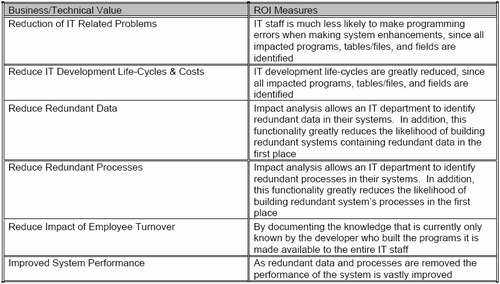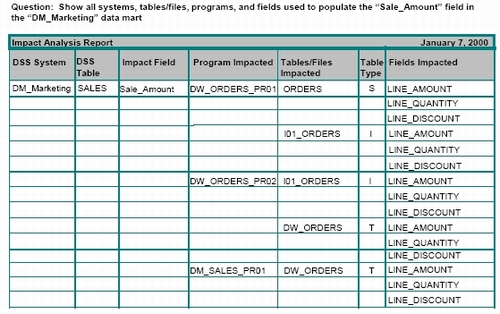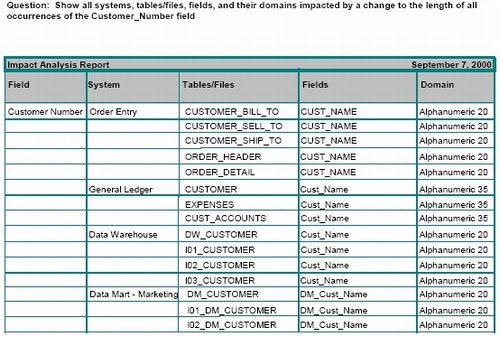Meta Data ROI: Making Your IT Department Better, Stronger, Faster
By David Marco
This article is adapted from the book “Building and Managing the Meta Data Repository“, John Wiley & Sons, ISBN # 0471-355232.
Chapter 1 “Introducing Meta Data and it’s Return on Investment” provides more detail on this topic. When selling in the concept of meta data to your corporation’s senior management there is only two things that they understand; Increasing Revenues or Decreasing Expenses. If you are not talking about increasing revenues or decreasing expenses you are the teacher on the old Peanuts cartoon, blah, blah, blah, blah, blah. This article marks the first in a series of articles on specifically defining how meta data can increase revenue and decrease expenses at your corporation’s IT (information technology) department. We will discuss the following techniques on how meta data can accomplish these goals:
-
Decision Support Impact Analysis
-
Enterprise Wide Impact Analysis
Table 1 list the value that impact analysis (both decision support and enterprise wide) can provide to a corporation.

Table 1: Meta Data ROI – Impact Analysis Benefits
Decision Support Impact Analysis
A meta data repository significantly reduces the costs of decision support systems development (decrease expenses) and the speed to market for new/modified decision support systems (increase revenues). Meta data accomplishes this through the use of technical impact analysis reports. These impact analysis reports significantly aid the decision support developers as they examine the impact of proposed changes into the decision support system’s environment. This type of functionality is critical for any company looking to manage their decision support system over time.
Decision support systems collect their data from the operational systems of a business. It is quite common that these operational systems will under go changes to their business rules and the data structures that can directly impact the decision support systems that they feed. Impact analysis reports meet this challenge. Let’s suppose that the table used to store customer data in the order entry system of a corporation was going to be modified. I could use the meta data in the meta data repository to run an impact analysis showing all of the decision support tables/files, programs, and fields that may be impacted by this change (see Figure 1). The “Table Type” field on the report in Figure 1 will equal one of three values: “S”, “I”, or “T”. “S” indicates that the table is a source table/file from the operational system to the decision support system. “I” signifies that the table is an intermediate table/file between the operational system and the decision support system. “T” indicates that the table/file is the target decision support table.

Figure 1: Meta Data ROI – Decision Support Impact Analysis
The decision support development team could then use this data to gauge the impact to the decision support system that this change to the operational system will have. This information would reduce the amount of time it would take for the decision support team to manually analyze the impact of these changes (reduce expenses), thereby reducing the development time to modify the decision support system (increase revenues). In addition, the likelihood of development errors is significantly reduced as all impacted programs are identified. The decision support team will need the option to limit the amount of information on the impact analysis; therefore they will need to be able to perform record selection on the following report attributes:
-
Source System
-
Source System Table
-
Source System Field
-
Decision Support System Table
-
Decision Support System Field
-
Table Type
Enterprise Wide Impact Analysis
Enterprise wide impact analysis expands the scope of the decision support impact analysis to include all of a company’s IT systems, not just the ones involved in the decision support process. We have kept these two topics separate because it is much easier for a corporation to build a meta data repository that stores meta data on the decision support system. This is because these systems are relatively new and as such have a much more advanced design and technology, as compared to the older operational systems. However meta data is every bit as important to these older systems as it is to our newer systems.
In order to understand the system impact of a major IT change requires a careful analysis of the current operational and decision support systems. A meta data repository significantly reduces the cost of development and the time frame needed to do it in. It accomplishes this by capturing the data transformation rules, data sources, data structures, and the context of the data in the IT systems. This is critical because without the repository the transformation rules would only be contained in the staff’s memory. The meta data significantly aids the analyst as they examine the impact of proposed changes into the system’s environment. This benefit will reduce the costs of future releases and help to reduce the propensity of new development errors. For example, let’s suppose that a company needed to expand the field length of their customer number from a 20-byte alphanumeric value to a 30-byte alphanumeric value throughout all of their systems. Figure 2 presents an enterprise wide impact analysis report showing all systems, tables/files, fields, and their domains impacted by a change to the length of all occurrences of the customer number field. This report clearly shows those systems and fields that cannot handle a 30-byte alphanumeric.

Figure 2: Meta Data ROI – Enterprise Wide Impact Analysis
-
System
-
System Table
-
System Field
-
Table Type
Business executives realize that knowledge is want differentiates corporations in the information age. Meta data is all about knowledge, and the capturing and accessibility of it. With meta data and a meta data repository corporations we will move from the “crawling” stage of information technology development to the “walking” stage.